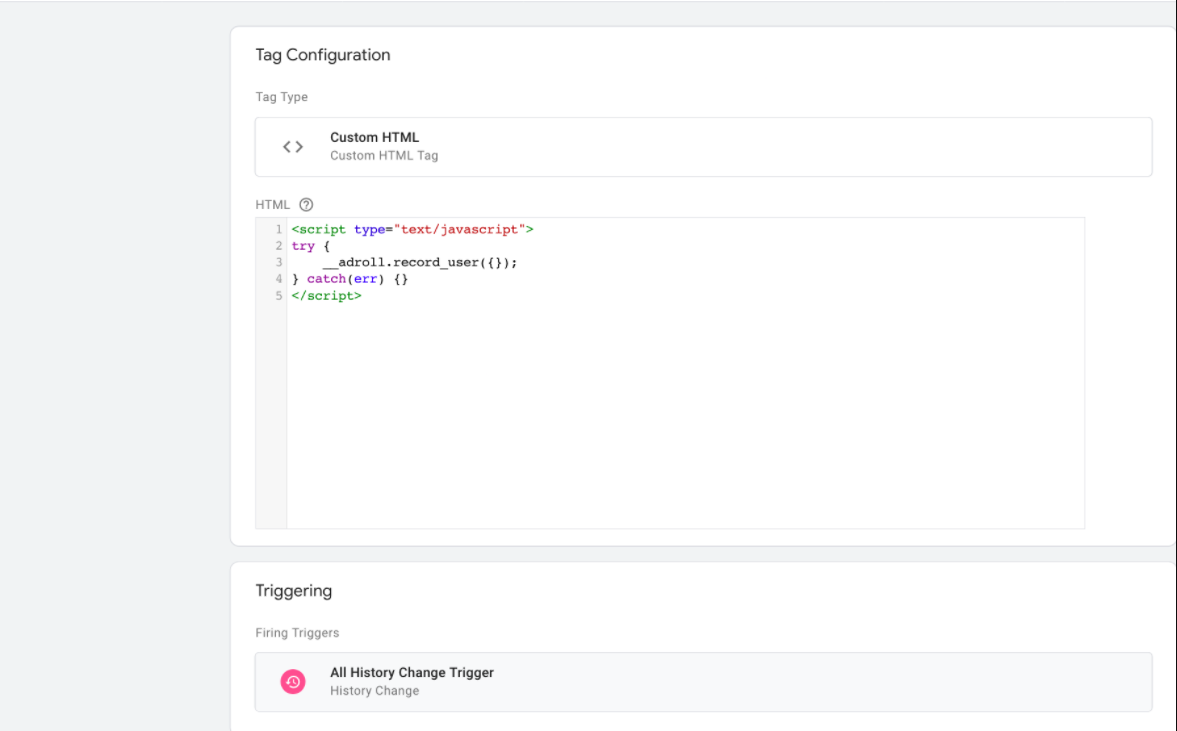Using AdRoll Pixel with Google Tag Manager on Shopify
You can add your AdRoll Pixel on Shopify if you're using Google Tag Manager and the TrackPixel.app to manage tags on your Shopify website.
Follow these instructions to install the Google Tag Manager pixel on your Shopify store.
Add Your AdRoll Pixel to Google Tag Manager
We recommend placing the AdRoll Pixel across all pages of your website through a single GTM tag that triggers on all pages.
- Navigate to Google Tag Manager > Workspace > Default Workspace.
- Click Add a New Tag.
- In the tag configuration, go to Choose tag type.
- Search for AdRoll.
- Select AdRoll SmartPixel > Continue.
- Configure your tag. The information that you need to add to Advertisable ID and Pixel ID can be found on your AdRoll Pixel.
- To pull up your AdRoll Pixel, navigate to AdRoll > Website > View Pixel.
- adroll_adv_id = Advertisable ID and adroll_pix_id = Pixel ID. Enter the corresponding code into the appropriate fields in your GTM tag. Leave Conversion Value and Segment Name blank.
- Click Continue.
- Specify your tag to fire on All Pages. In Trigger configuration, select a trigger that fires on All DOM Ready Events with Page View - DOM Ready trigger type. If you don't find this trigger type, then save the AdRoll Pixel tag and create a new trigger:
- Go to Triggers > New.
- Select DOM Ready in Page View as a trigger type.
- Enter a name for the trigger All Page View - DOM Ready Events
- Save.
- Go back to where you left off in Tags and select your new trigger.
- Click Create Tag to complete setup. If you need to edit your tag in the future, you can pull it up by going to the Tags section of your GTM.
Enhanced Conversion Tracking
Learn how to set up enhanced conversion tracking and define custom parameters here.
Stored Revenue Data
If you're unsure where on your conversion page your revenue data is stored, your best option is to consult with your technical team.
The most common places are DOM Elements, Javascript Variables, and DataLayer Variables.
DOM Elements are HTML tags within the page. These include everything from images (<img>), paragraphs (<p>), various inputs (<input>).
Event-Based Audience in Google Tag Manager
Most audiences can be tracked based on the various URLs on your website. However, there are some cases where you want to track audiences that perform a certain action such as the OnClick of a button or submitting a form. To track this audience you'll need to create an event-based audience within your AdRoll dashboard.
Once the audience is created, use the steps below to tie the audience to the OnClick event on your website.
- In your GTM account, go to Workspace > Default Workspace > Add a New Tag.
- In the tag configuration, go to Choose tag type > Custom HTML.
- Copy the event snippet for your audience from the AdRoll dashboard as outlined here.
- Paste the snippet in the GTM Custom HTML tag, and make sure the code is within <script> tags.
- Choose an existing trigger for the relevant button's OnClick function or form of success if it exists.
- If the button trigger does not exist, create a new trigger through these instructions and select your newly created trigger.
- Enter a name for the tag, save the tag and repeat the process for all other event-based audiences.
- Publish the workspace.
Single Page Application in Google Tag Manager
If you're working with a single page application, here's how to track your conversions.
- Create a new trigger and name it.
- Set the Trigger Type to "History Change."
- Leave the default for This trigger fires on: "All History Changes."
- Create a new Custom HTML tag and name it (e.g. "AdRoll - History Changes").
- Paste the following snippet into the HTML box:
<script type="text/javascript">
try {
__adroll.record_user({});
} catch(err) {}
</script> - Set the tag to trigger on the All History Changes trigger you just created. It should look like this:

- Save and publish your changes.
More information can be found here: https://help.adroll.com/hc/en-us/articles/212675687-Google-Tag-Manager